3 - Add Joint Surface
1.0 Introduction
The shape, size and spatial distribution of joint structures may be defined as any arbitrary planar/surface geometry, or a collection of discrete planar surfaces; these can include faults, folding fractures, foliations, or Discrete Fracture Networks (DFNs). This tutorial covers the use of an imported cross-jointed Discrete Fracture Network (DFN) which will be used to model the joints in RocSlope3. The DFN consists of bedding planes dipping 30 degrees toward the east and orthogonal cross-joints.
Finished Product
The finished product of this tutorial can be found in the Tutorial 03 Add Joint Surface folder. All tutorial files installed with RocSlope3 can be accessed by selecting File > Recent Folders > Tutorials Folder from the RocSlope3 main menu.
2.0 Opening the Starting File
- Select File > Recent > Tutorials Folder in the menu.
- In the Tutorial 03 Add Joint Surface folder, open the file Tutorial 03 Add Joint Surface - starting file.rocslope_model.
This model already has the following defined and provides a good starting point to start defining joint surfaces:
- Project Settings
- Material Properties
- External Geometry
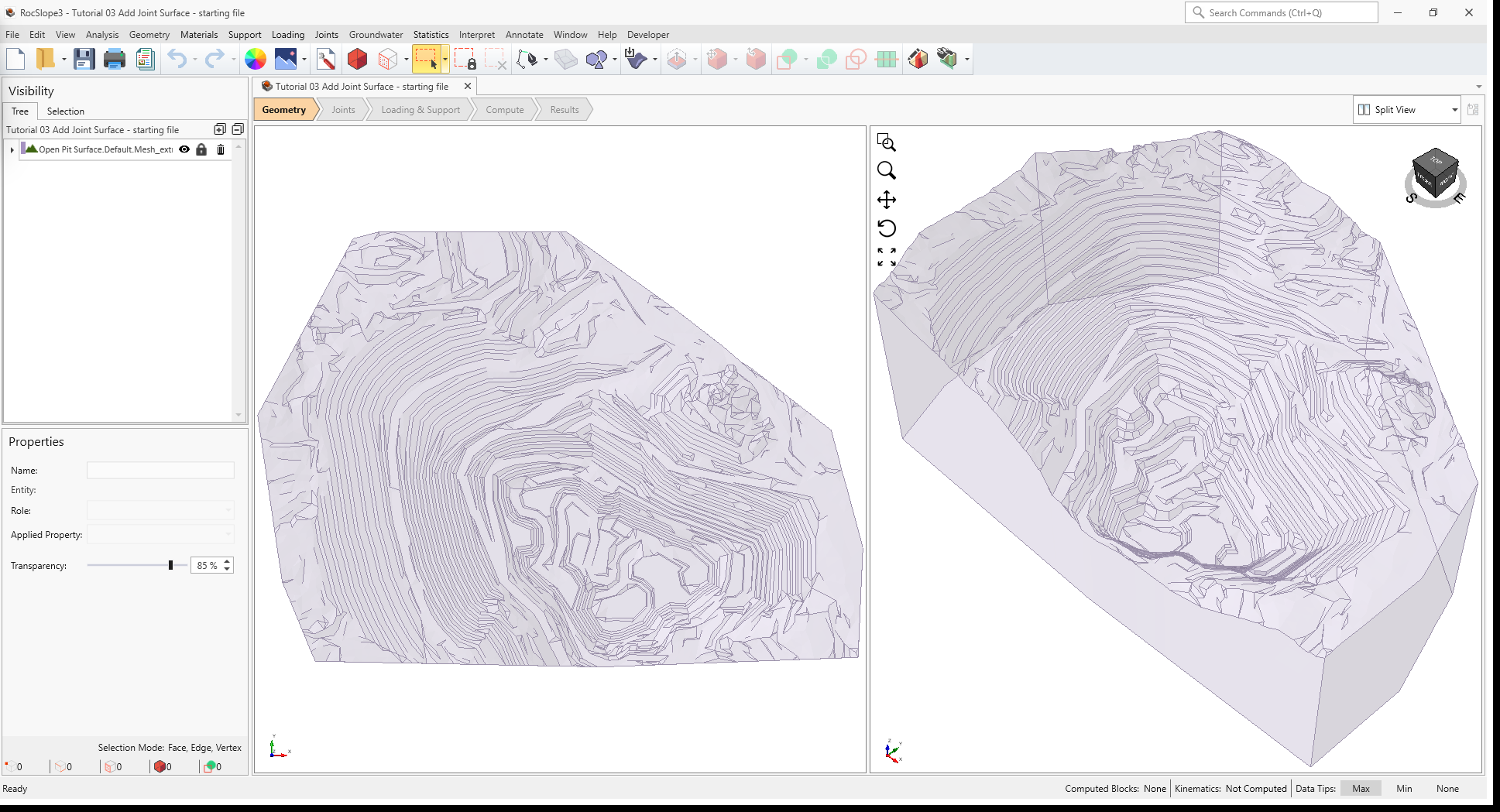
2.1 Project Settings
Review the Project Settings.
- Select Analysis > Project Settings

- Select the Units tab. Ensure Units are Metric, stress as
MPa.
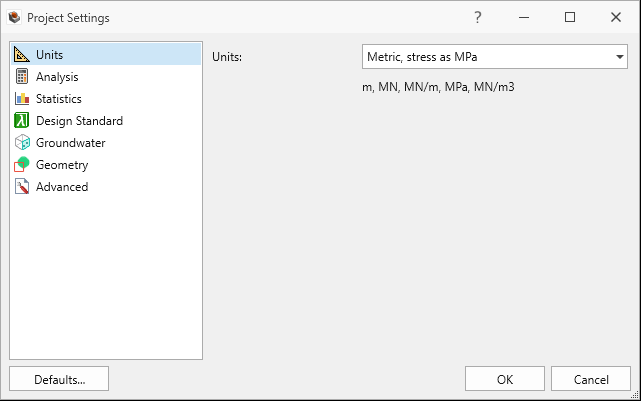
Units tab in Project Settings dialog - Select the Analysis tab.
- Ensure Design Factor of Safety = 1.2.
- Ensure Successive Failure = OFF. We will only be analyzing the blocks which daylight
and are readily removable.
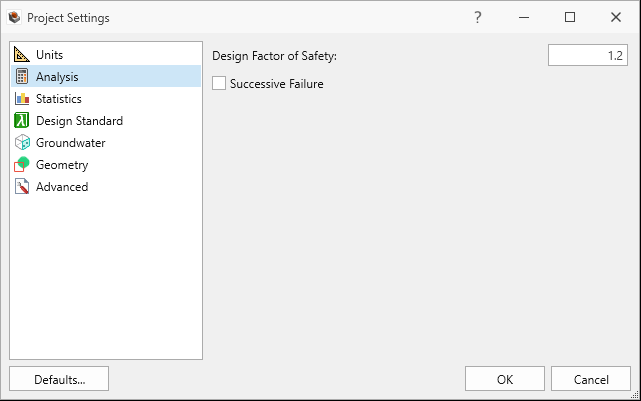
Analysis tab in Project Settings dialog
- Click Cancel to close the dialog.
2.2 Material Properties
Review the Material Properties.
- Select Materials > Define Materials

- One (1) material property is defined. The Schist material property has:
- Unit Weight = 0.026 MN/m3.
- No Water Surface applied.
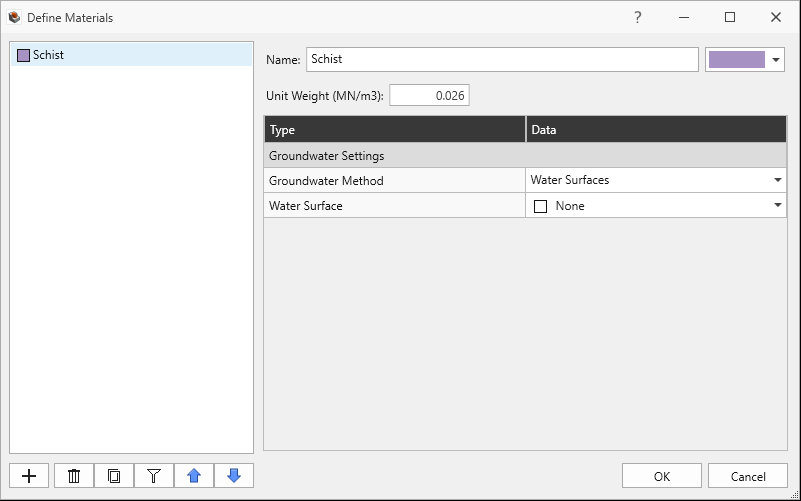
Schist Material Property in Define Materials dialog
- Click Cancel to exit the dialog.
2.3 External Geometry
The External is of a pit shell and composed of one volume assigned with the Schist material
property.
3.0 Defining Joint Properties
- Navigate to the Joints workflow tab

- Select Joints > Define Joint Properties

- Enter the following properties for Joint Property 1:
- Name = Smooth
- Under the Strength tab:
- Strength Model = Mohr-Coulomb
- Cohesion = 0 MPa
- Phi = 10 deg
- Override by Material = OFF
- Waviness = 0 deg
- Under the Water Parameters tab:
- Water Pressure Distribution = Dry
- Click OK to save and close the Define Joint Properties dialog.
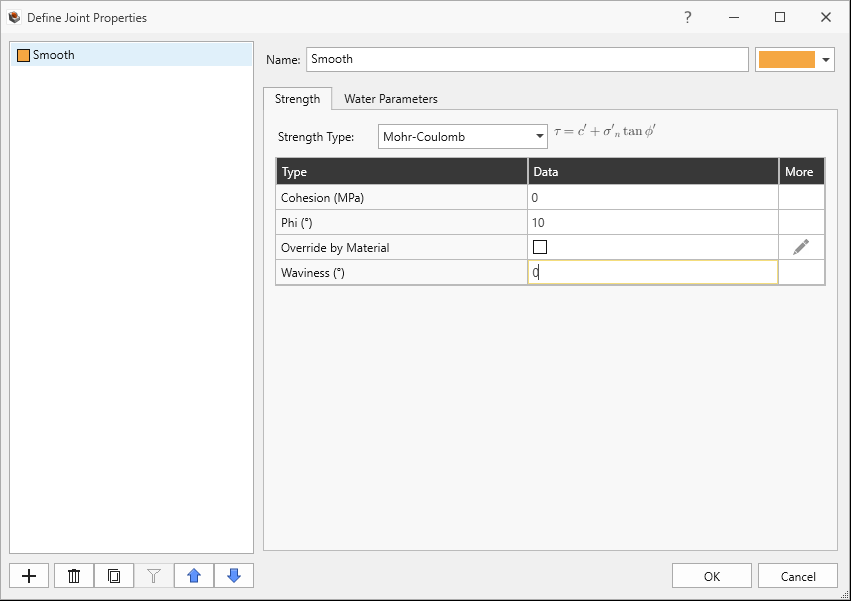
Smooth Joint Property Strength tab in Define Joint Properties dialog 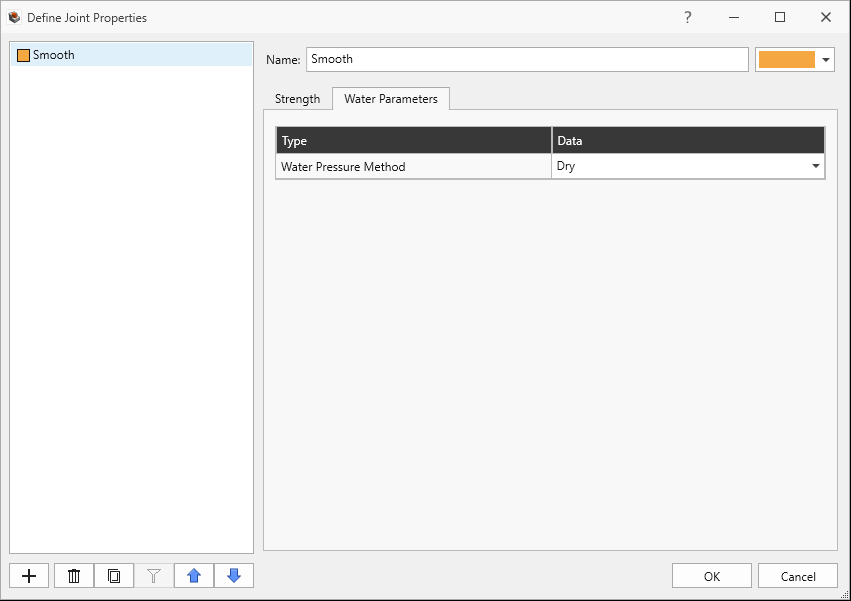
Smooth Joint Property Water Parameters tab in Define Joint Properties dialog
The Define Joint Properties dialog will open. This dialog allows users to define the Strength Model, Waviness, and Water Pressure for each joint property.
4.0 Add Joint Surface
In this example, we will be defining joint surfaces from a DFN geometry file. To import the DFN geometry:
- Select File > Import > Import Geometry
 . Several geometry file formats are
supported. See the Import Geometry topic for more information.
. Several geometry file formats are
supported. See the Import Geometry topic for more information. - In the Open dialog, select the DFN Cross-Jointed.rsgeomobj file from the Tutorials 03 Add Joint Surface folder and click Open.
- The Import Geometry dialog shows the file(s) and mesh entities available for import and a
preview of the entity.
- Select All Geometry.
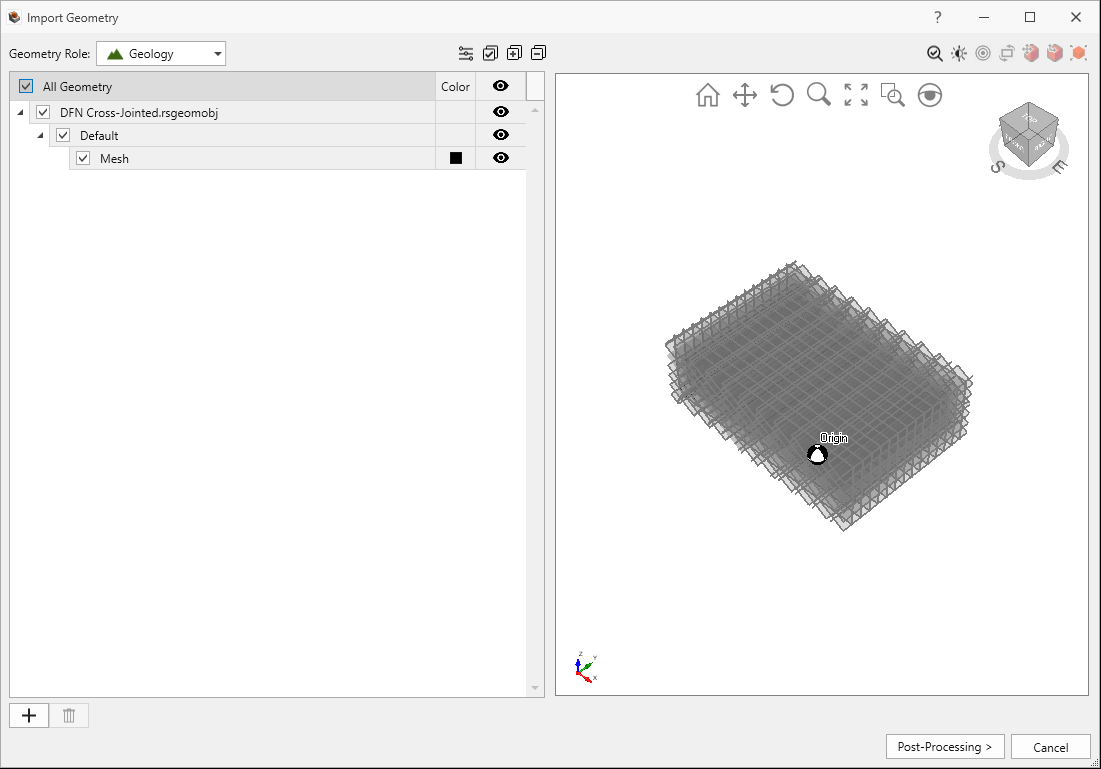
DFN Cross-Jointed mesh in Import Geometry dialog - Click Post-Processing.
- Click Done to import the geometry.
- Select All Geometry.
The geometry is imported into RocSlope3 and shown in the Visibility Tree. When selected, you will see the following under the Properties pane:
- Name = DFN Cross-Jointed.Default.Mesh
- Entity = Surface
- Role = Geology
- Transparency = 85%, by default
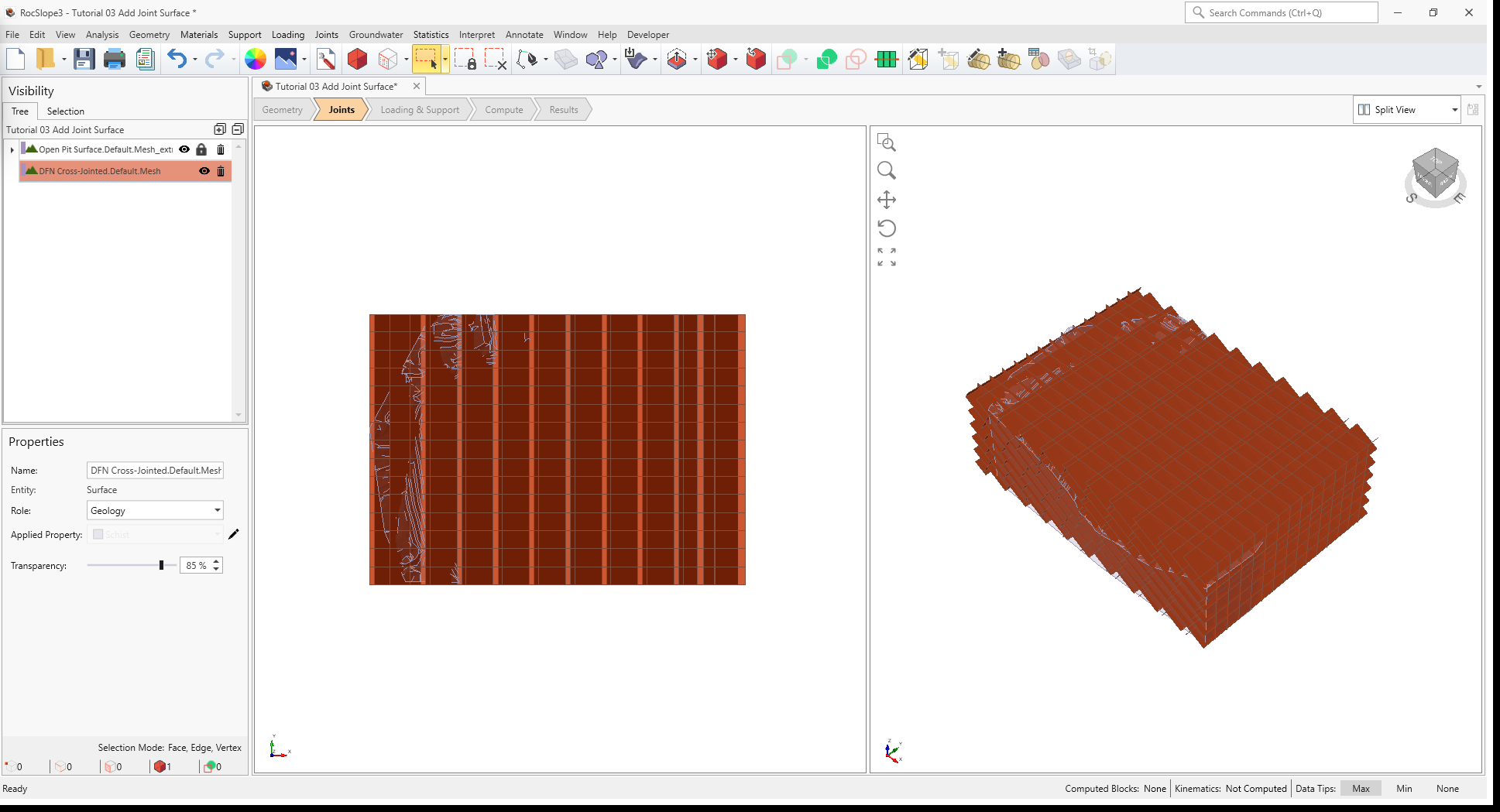
4.1 Add Joint Surface
In order for RocSlope3 to treat the imported surface as joints, it must be assigned as a joint surface using the Add Joint Surface option.
- Ensure you are still in the Joints workflow tab

- Select the DFN Cross-Jointed.Default.Mesh node from the Visibility Tree.
- Select Joints > Add Joint Surface

- In the Add Joint Surface dialog:
- Set the Joint Property = Smooth. Each face of the entity is treated as a separate joint
by RocSlope3, all with the assigned Joint Property.
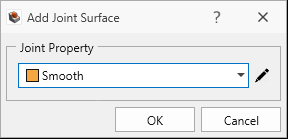
Add Joint Surface dialog - Click OK to set the entity as a Joint Surface.
- Set the Joint Property = Smooth. Each face of the entity is treated as a separate joint
by RocSlope3, all with the assigned Joint Property.
Select the Joint Surface entity in the Visibility Tree and the entity will be selected (highlighted red). The following information is shown in the Properties pane:
- Name = Joint Surface
- Entity = Surface
- Applied Property = Smooth
- Transparency = 0%, by default
The joints are drawn in the 3D View.
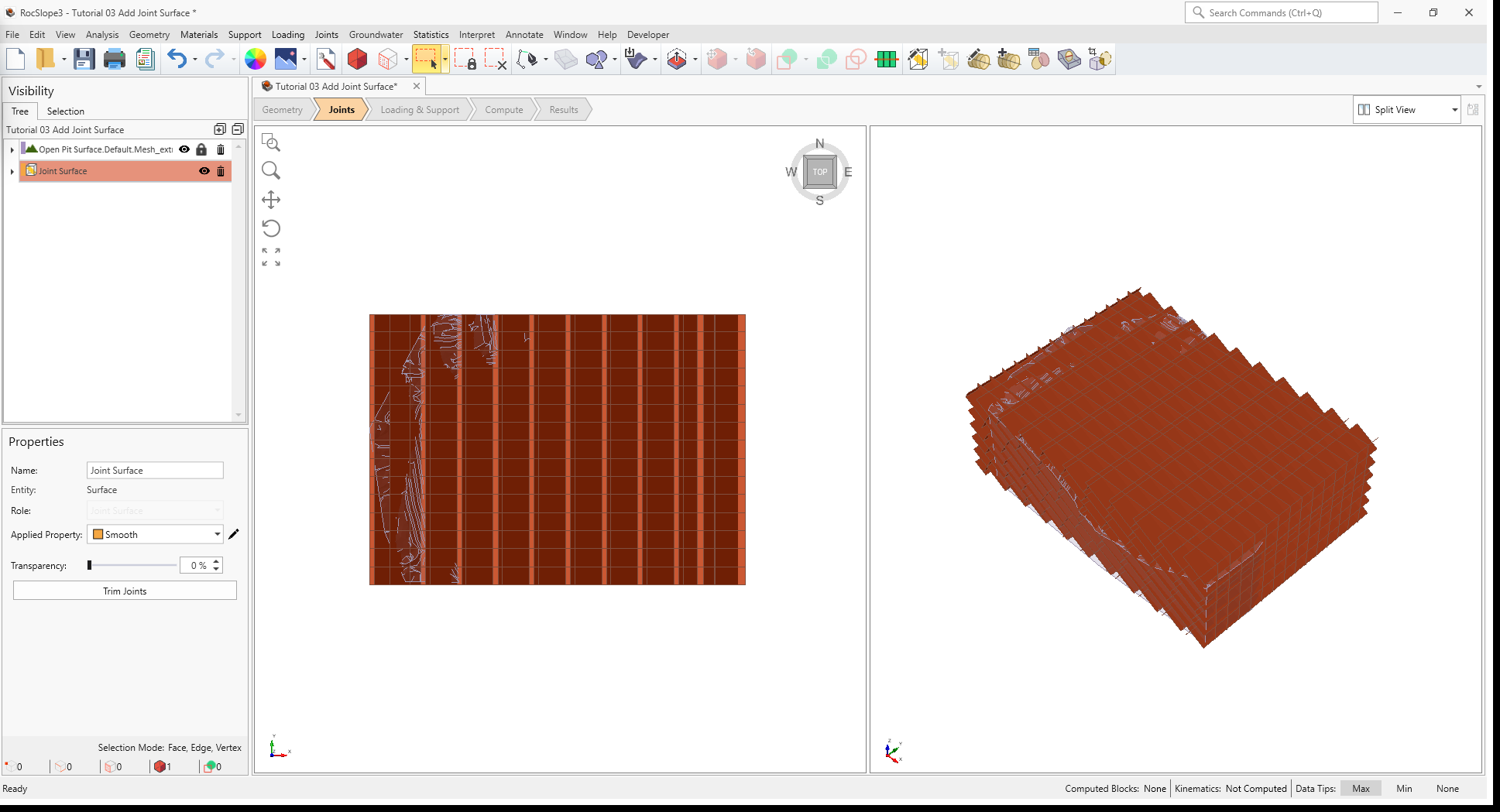
5.0 Compute
RocSlope3 has a two-part compute process.
5.1 Compute Blocks
The first step is to compute the blocks which may potentially be formed by the intersection of joints with other joints and the intersection of joints with the free surface.
To compute the blocks:
- Navigate to the Compute workflow tab

- Select Analysis > Compute Blocks

As compute is run, the progress bar reports the compute status. Once compute is finished, the Results node is added to the Visibility Tree and All Valid Blocks are blocks are shown in the 3D View. The Results node consists of the collection of valid blocks and the socketed slope. The original External and Joint Surface visibility is turned off.
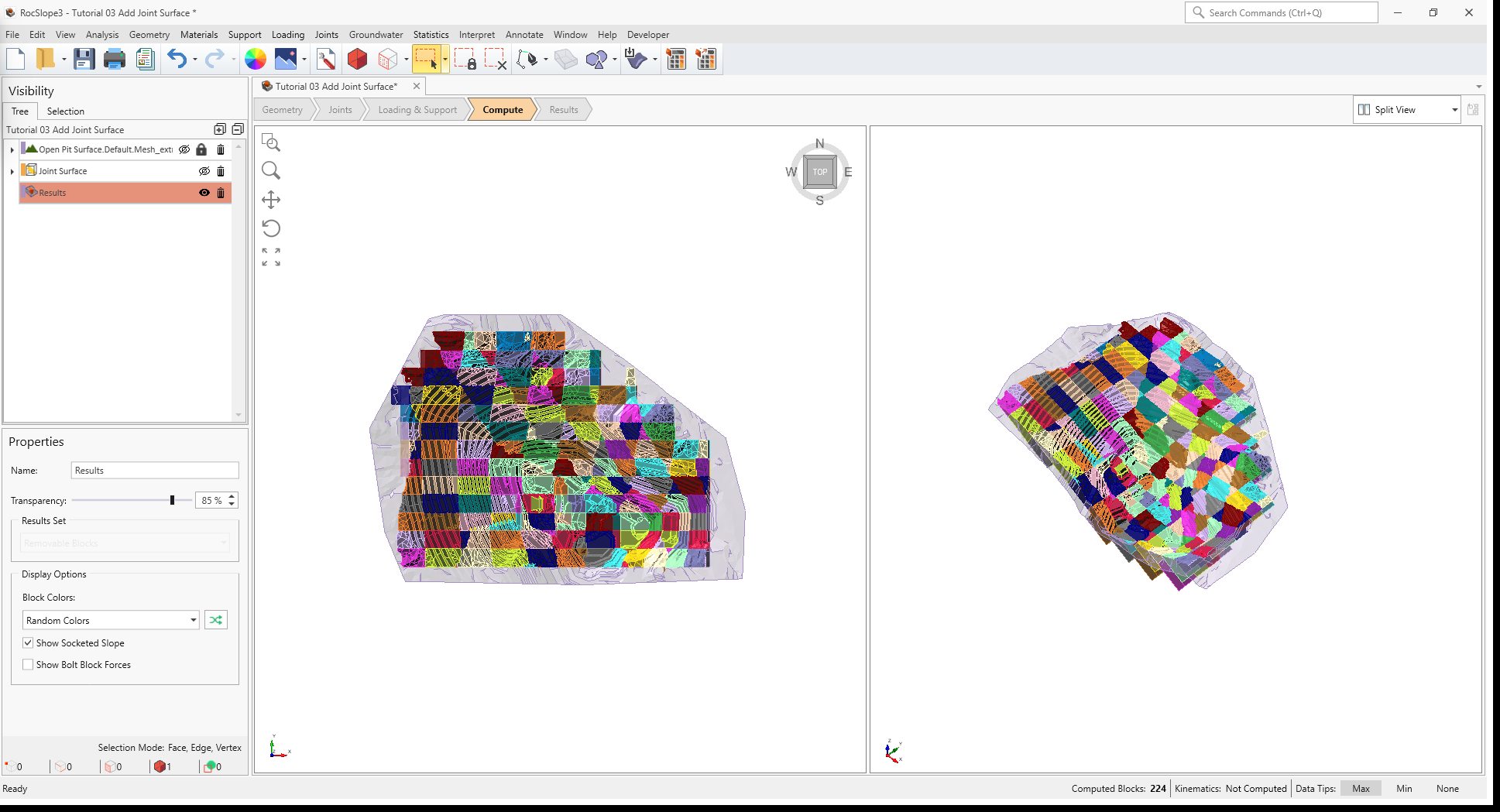
Once compute is finished, the blocks are coloured according to the Block Color option (Random Colors) set in the Results node's Property pane.
Compute Blocks only determines the geometry of the blocks. In order to obtain other information such as the factor of safety, Compute Kinematics needs to be run.
5.2 Compute Kinematics
The second and final compute step is to compute the removability, forces, and factor of safety for each of the valid blocks.
To compute the block kinematics:
- Ensure that the Compute workflow tab
 is the active workflow.
is the active workflow. - Select Analysis > Compute Kinematics

As compute is run, the progress bar reports the compute status. By default, after Compute Kinematics is run, only Removable Blocks are shown.
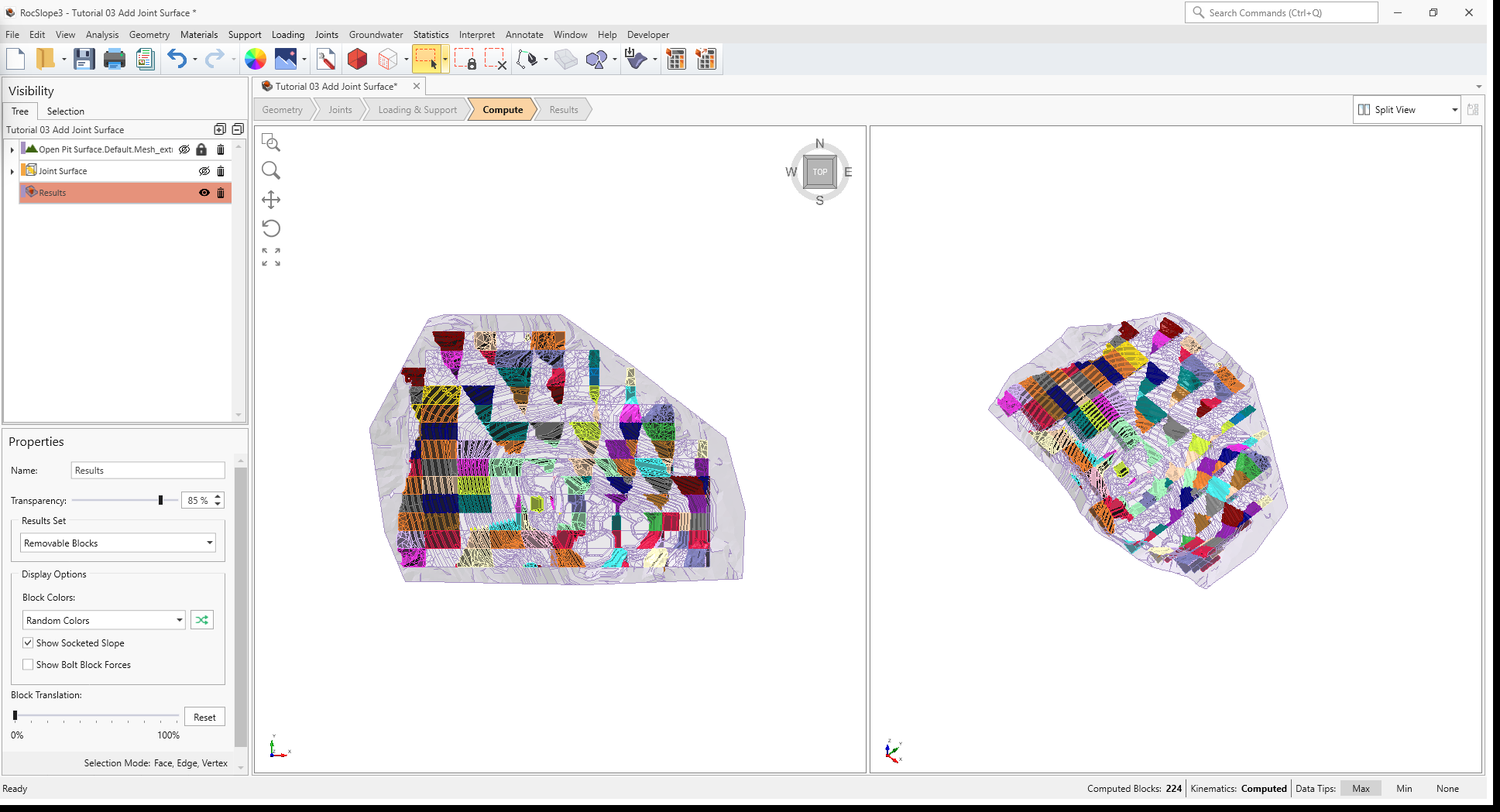
6.0 Interpreting Results
Once both blocks and kinematics are computed, all block results can be viewed in a table format.
6.1 Block Information
To view all block results:
- Navigate to the Results workflow tab

- Select Interpret > Block Information

Visualizing blocks can be difficult when the slope extents are large compared to the block extents.
To zoom into all blocks:
- Select Interpret > Zoom To All Blocks

The Block Information pane shows the collection of blocks according to the Results Set settings. The Results Set shown can be selected in the Results tab of the Display Options, or the Properties pane for the Results Node. In this case, only Removable Blocks are coloured and listed in Block Information.
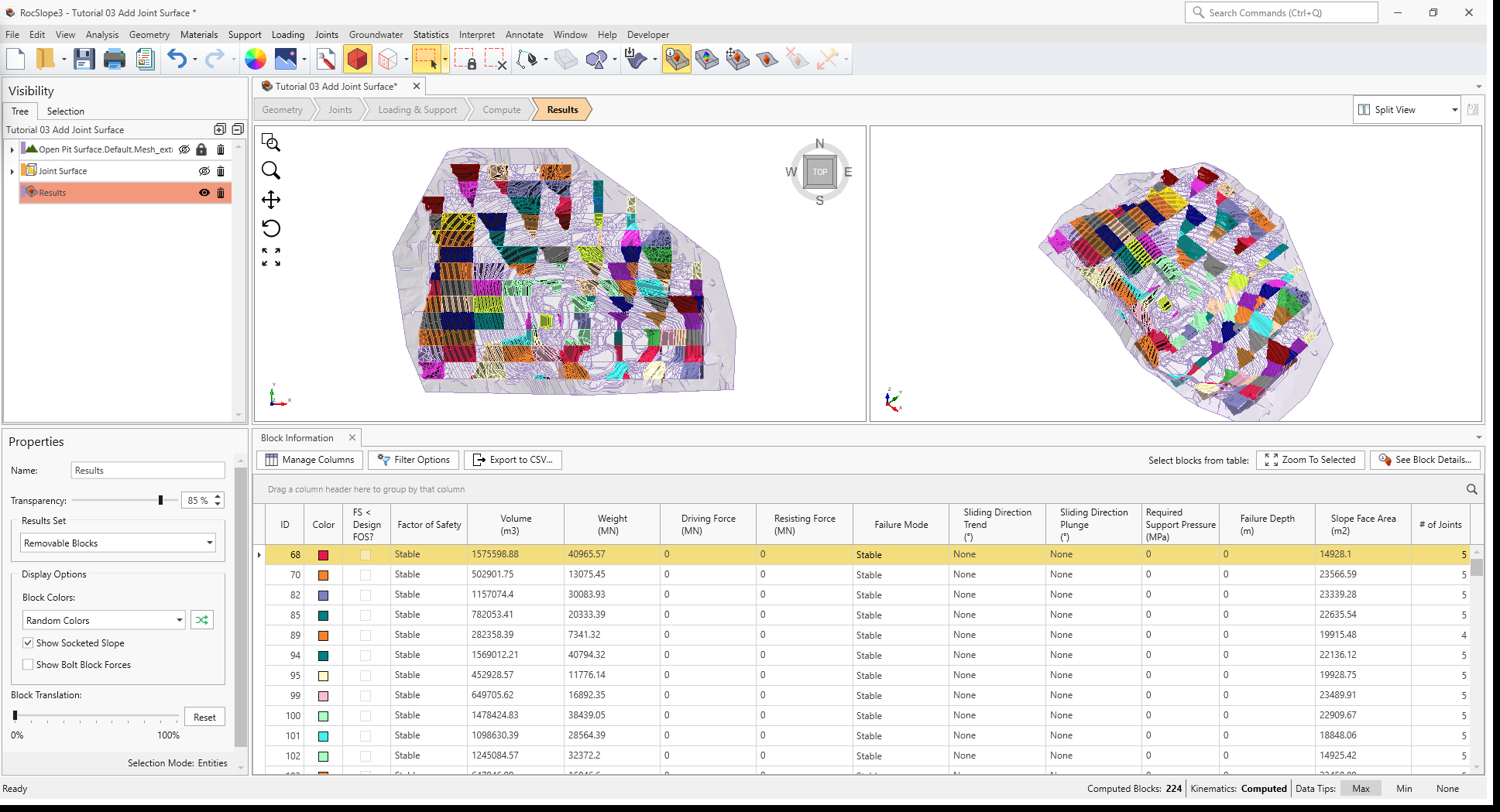
To view only failed blocks which have a Factor of Safety less than the Design Factor of Safety (i.e., FS < 1.2):
- Select View > Display Options

- Navigate to the Results tab.
- Set Results Set = Failed Blocks (FS < Design FS).
- Click OK to close the dialog.
OR
- Select the Results node from the Visibility Tree.
- In the Results node Properties pane, set Results Set = Failed Blocks (FS < Design FS).
Failed Blocks are now coloured and listed in the Block Information pane.
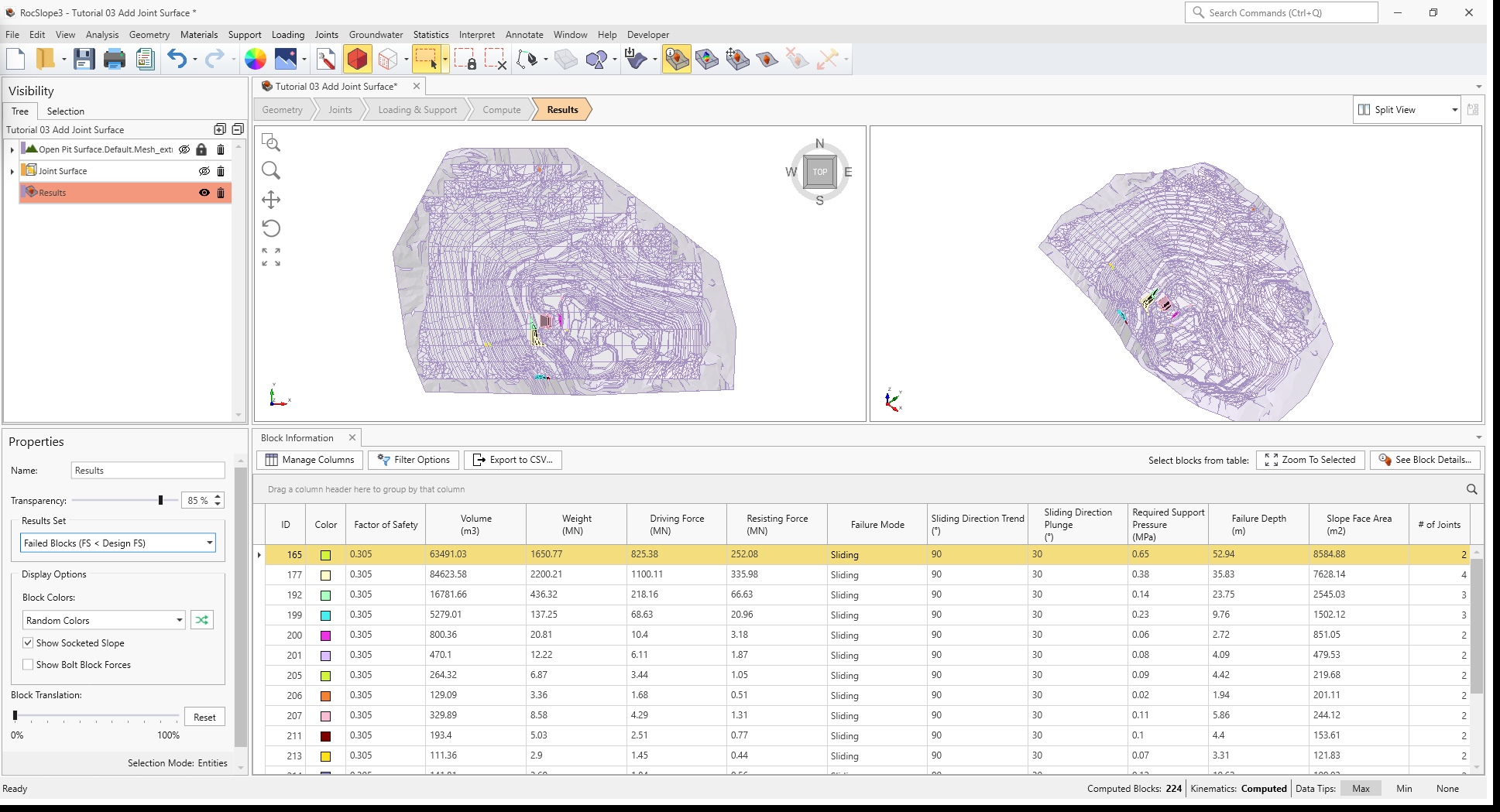
All failed blocks occur on the west side of the pit shell since the bedding planes dip in the same direction as the west portion of the slope. They also have the same factors of safety since they all slide on the bedding planes which have a constant dip angle and only friction angle is considered. These are all planar type failures where sliding occurs on one joint only.
This concludes Tutorial 03.